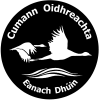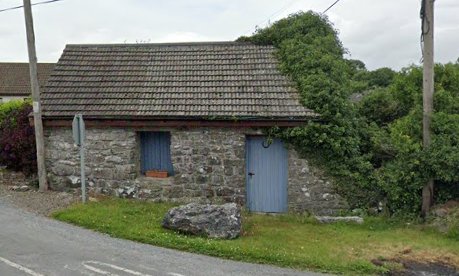By Irene McGoldrick

Please note that Cloonboo Castle is situated on private land and is not accessible to the public, but can be seen from the Headford Road.
Cloonboo Castle, located in the townland of Castlequarter, is one of a number of tower houses situated in the parish of Annaghdown, most of which were built by the De Burgos. 24 castles in the Barony of Clare were identified by Col J.P. Nolan as in existence in the year 1574 in an annexed list ‘compiled for the use of the Lord Deputy, Sir Henry Sidney, who planned the composition of Connaught, which was carried into effect in by Sir John Perot in, 1585’ when ‘Cloynebow’ Castle was in the possession of Moyler McShean1.
The archaeological features of Cloonboo Castle were recorded by Alcock, De hÓra and Gosling in 1999:
On a slight rise, in low lying marshy bogland. In existence in 1574 when it was in the possession of Moyler McShean (Nolan 1901b, 118). A poorly preserved rectangular four storey tower (L 12.3m Wth 10.6m) heavily overgrown with ivy. Almost all the dressed stones have been removed and there is a breach on the ENE wall. The robbed out doorway in NNW wall leads to a small entrance lobby with a murder hole above. A short intramural stairs to S leads to the spiral staircase. A stone vault exists between ground / first floor. The garderobe is ENE wall on 1st floor and its flue is visible within a window embrasure overhead on second floor. Projecting corbels on top of NNW wall, over the doorway, indicate the former presence of a machicolation. Some slit and flat-headed rectangular windows survive. There is a holy well c. 40m to SE, while 30m to E is a possible moated site.2
The Lynch Blosse papers recite a number of deeds pertaining to Cloonboo Castle, including a 1610 deed granting the ‘right, title and interest in the castle of Clowne Bowe’ to John Bourke fitz Riccard of Dery mc Lagney.3 A 1611/12 deed outlined a controversy between John Boorke of Derremclaghney and Henrie Lynch whereby, for a payment of £40, Sir Henry Lynch was granted rights to the caste of Clownbowe.4 A final deed in 1633 between Joseph Hampton and daughter granted and surrendered the Castle to Sir Henry Lynch and other members of his family.5 Sir Henry Lynch died in 1635 with his estate granted to his son and heir Sir Robuck Lynch.
The 1641 Depositions in Trinity College Dublin contain accounts ‘from Protestant men and women of all classes [who] told of their experiences following the outbreak of the Catholic rebellion of 1641’. Amongst these depositions is an account from Joseph Hampton (who had granted Sir Henry Lynch and family the castle in the above deed), where he claims that he was ‘forcibly deprived, robbed and dispoyled of a lease of the Castle and five quarters of land of Clanbowe.’ by Sir Robert [Robuck] Lynch’s brother, Captain Morris Lynch, forcibly took possession of the castle with 18 tenants and servants, under threat of being strung out the castle window, the Hamptons were forced to provide them with ‘such meat and drinke as would please their humours,’ for the next fortnight6. In a later examination in 1653, Hampton stated that Sir Robuck Lynch had in summer 1640 brought a blacksmith named William McCane or McOwen, from the high road from Shrule to Claregalway, to make pikes and ‘murderinge weapons’ at Drumgriffin, where he kept the smith a long time employed. He stated that John Allen of Cloonboo and Edmund McWilliam Burke of Castlecreevy would testify to this information7.
During the Cromwellian Plantations, Sir Robert Lynch’s lands were seized and the Lynches were granted land in Carra, Co. Mayo. Cloonboo Castle was granted to Col. William Legge. Another Catholic family, the Skerretts, found themselves in a similar position when they were dispossessed of Headford Castle, which had been granted to the St. George family. Legge subsequently sold much of the land in the parish to Marcus ffrench and James Skerrett in 1675.8 James Skerrett’s son, Anthony, inherited his estate sometime after 16819, and was described as ‘Anthony Skerrett of Clonebue Esq.’ in a 1696 deed.10 By 1783 James Skerrett, son of Anthony and heir apparent, was first party to a deed of lease and release to his first cousin, Dominic Skerrett of Ballinduff, which included the lands of Cloonboo.
The Skerretts found themselves in financial difficulty in the mid 18th century and a resulting 1788 Bill, 28 George III, c.47 was enacted for vesting the estate of James Skerrett in trustees for the payment of debts and encumbrances. In 1791, Francis Blake of Rahara, Co. Roscommon, and William Keller of Dublin purchased part of the estate of James Skerrett, including Cloonboo, from the trustees for £2000. It is unlikely tha the Blakes ever lived in Cloonboo Castle, and as James Blake, son of Francis, was leasing Cregg Castle from Richard Kirwan in 1804, Cloonboo Castle is likely to have been uninhabited from at least that time. Cloonboo Castle is now privately owned.
1 Nolan, J.P., ‘Galway Castles and Owners in 1574’, Journal of the Galway Archaeological and Historical Society, 1901, Vol. 1, No. 2, pp. 109, 118.
2 The above description is derived from the published ‘Archaeological Inventory of County Galway Vol. II – North Galway’. Compiled by Olive Alcock, Kathy de hÓra and Paul Gosling (Dublin: Stationery Office, 1999) and can be viewed on the Historic Environment Viewer application on www.archaeology.ie
3 Nicholls, K.W., ‘The Lynch Blosse Papers’, Analecta Hibernica, 1980, No. 29, p. 163.
4 Ibid.
5 Ibid p. 170.
6https://1641.tcd.ie/index.php/deposition/?depID=830138r107
7https://1641.tcd.ie/index.php/deposition/?depID=830259r178
8 Blake, Martin J., ‘An Old Lynch Manuscript (Continued)’, Journal of the Galway Archaeological and Historical Society, 1914, Vol. 8, No.4, p. 219
9 Crossle, Philip, ‘Some Records of the Skerrett Family’, Journal of the Galway Archaeological and Historical Society, 1931, Vol. 15, No 1/2, p.37.
10 Blake, Martin J., ‘An Old Lynch Manuscript (Continued)’, Journal of the Galway Archaeological and Historical Society, 1914, Vol. 8, No.4, p. 221.



